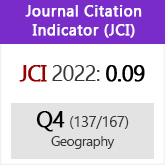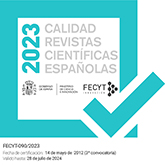Development of a methodology for the study of floods caused by ponding of rainfall water in relatively flat urban zones. Studied area: Montería (Colombia)
DOI:
https://doi.org/10.3989/estgeogr.201509Keywords:
rainfall, soil units, infiltration, flood, susceptibility, vulnerabilityAbstract
In this paper a methodology for the analysis of the relationship between rainfall and flooding caused by ponding of rainfall water in urban area of Monteria (Colombia) is developed. Rainfall water excesses over the soil were estimated from field measurements of the soil infiltration capacity for different soil units of the studied zone. The results obtained are presented in form of statistical correlations for calculating water rainfall excesses over the soils and maps of susceptibility and vulnerability for floods. The maps were used for a brief socioeconomic discussion of the effects of flood events in the selected zone.
Downloads
References
Arranz Lozano, M. (2008): "El riesgo de inundaciones y la vulnerabilidad en áreas urbanas. Análisis de casos en España". Estudios Geográficos, LXIX/265, pp. 385-416. http://dx.doi.org/10.3989/estgeogr.0417
Ayala Carcedo, F. (2000): "La ordenación del territorio en la prevención de catástrofes naturales y tecnológicas. Bases para un procedimiento técnico-administrativo de evaluación de riesgos para la población". Boletín de la A.E.G., 30, pp. 37-49.
Chica, Y. y Padilla, M. (2006): "Análisis del comportamiento de la precipitación y su relación con las inundaciones en Montería". Tesis de pregrado, Departamento de Geografía y Medio Ambiente, Universidad de Córdoba.
Clichevsky, N. (2006): "Estado, mercado de tierras urbanas e inundaciones en ciudades argentinas". Cuadernos de Geografía, 15, pp. 31-52.
CVS (2004): Diagnóstico ambiental de la cuenca hidrográfica del río Sinú. Montería, Corporación Regional de los Valles del Sinú y del San Jorge, Centro de Documentación.
Díez, A.; Lain, L. y Llorente, M. (2006): Mapas de peligrosidad de avenidas e inundaciones. Métodos, experiencias y aplicación. Madrid, Publicaciones del Instituto Geológico y Minero de España. Serie Medio Ambiente, Riesgos Geológicos, 7.
Domínguez Mora, R. (2000): "Las inundaciones en la ciudad de México. Problemática y alternativas de solución". Revista Digital Universitaria, 1/2. Disponible en http://www.revista.unam.mx/vol.1/num2/proyec1/ (Verificada el 23/04/2015).
Gobernación (2013): Córdoba: Plan Departamental de Gestión del Riesgo. Montería, Gobernación de Córdoba.
Hardoy, J. y Romero Lankao, P. (2011): "Latin American cities and climate change: challenges and options to mitigation and adaptation responses". Current Opinion in Environmental Sustainability, 3/3, pp. 158-163. http://dx.doi.org/10.1016/j.cosust.2011.01.004
Hernández Rodríguez, L. C. y Cubillos Pe-a, C. E. (2012): "Consideraciones de planteamiento de una metodología para evaluar el riesgo público por inundación considerando el sistema de drenaje urbano", en: XX Seminario Nacional de Hidráulica e Hidrología, Barranquilla.
Jacobson, C. R. (2011): "Identification and quantification of the hydrological impacts of imperviousness in urban catchments: a review". Journal of Environmental Management, 92, pp. 1438-1448. http://dx.doi.org/10.1016/j.jenvman.2011.01.018 PMid:21334133
Kazmierczak, A. y Cavan, G. (2011): "Surface water flooding risk to urban communities: Analysis of vulnerability,hazard and exposure". Landscape and Urban Planning, 103, pp. 185-197. http://dx.doi.org/10.1016/j.landurbplan.2011.07.008
Materón Mu-oz, H. (1985): Hidrología Básica II. Cali, Facultad de Ingeniería, Universidad del Valle.
Olcina Cantos, J. (2009): "Cambio climático y riesgos climáticos en España". Investigaciones Geográficas, 49, pp. 197-200. http://dx.doi.org/10.14198/INGEO2009.49.10
ONU (2004): Living with risk. United Nations: International Strategy for Disaster Reduction, I.
Parker, D. J. (2000): Flood. 2. London-New York, Routledge and Sons.
POT (2009): Proceso de revisión y ajuste al POT de Montería 2002-2015, Capítulo II, documento técnico. Disponible en http://cdim.esap.edu.co/BancoMedios/Documentos%20PDF/monteriacordobapot2002-2015.pdf (Verificada el 23/04/2015).
Qin, H., Li, Z. y Fu, G. (2013): "The effects of low impact development on urban flooding under different rainfall characteristics". Journal of Environmental Management, 129, pp. 577-585. http://dx.doi.org/10.1016/j.jenvman.2013.08.026 PMid:24029461 Schmitt, T. G.; Thomas, M. and Ettrich, N. (2004): "Analysis and modeling of flooding in urban drainage systems". Journal of Hydrology, 299, pp. 300-311. http://dx.doi.org/10.1016/S0022-1694(04)00374-9
SDA (2011): Sistemas Urbanos de Drenaje Sostenible. Bogotá, Secretaría Distrital de Ambiente.
SSPD (2009): Sistema de alcantarillado en Colombia. Visión del servicio público. Bogotá, Superintendencia de Servicios Públicos Domiciliarios
Stevaux, J. C.; Latrubesse, E. M.; Hermann, M. L. de P. y Aquino, S. (2009): "Flood in urban areas of Brazil". Developments in Earth Surface Processes, 13, pp. 245-266. http://dx.doi.org/10.1016/S0928-2025(08)10013-X
Tucci, C. E. M. (2002): Improving flood management practices in South America: workshop for decision makers. Geneva, World Meteorological Organization: Associate Program on Flood Management: South America.
Downloads
Published
How to Cite
Issue
Section
License
Copyright (c) 2015 Consejo Superior de Investigaciones Científicas (CSIC)

This work is licensed under a Creative Commons Attribution 4.0 International License.
© CSIC. Manuscripts published in both the printed and online versions of this Journal are the property of Consejo Superior de Investigaciones Científicas, and quoting this source is a requirement for any partial or full reproduction.All contents of this electronic edition, except where otherwise noted, are distributed under a “Creative Commons Attribution 4.0 International” (CC BY 4.0) License. You may read here the basic information and the legal text of the license. The indication of the CC BY 4.0 License must be expressly stated in this way when necessary.
Self-archiving in repositories, personal webpages or similar, of any version other than the published by the Editor, is not allowed.
















